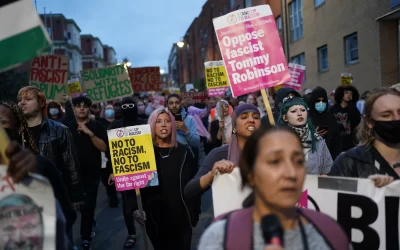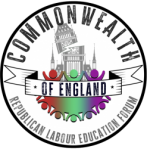
The Commown Wealth Party (1942-46)
During the Second World War a new left wing party emerged that captured the mood of the working class in those dangerous and turbulent times. The Common Wealth party was set up in July 1942 from a merger of JB Priestley’s 1941 Committee and Forward March led by former Liberal MP Sir Richard Acland. Priestley, the first leader of the party, resigned in the autumn of 1942. Acland, a rich landowner, took over and in 1943 gave his hereditary estates to the National Trust in line with his Christian socialist views about the morality of private wealth. He was a very persuasive speaker who could fill any hall in any town with his message of a New Jerusalem.(1) Appealing to the audience, he would call for them to renounce their privileges and snobbery and join the cause of a classless society.(2)
The party recruited a small but significant and enthusiastic membership. This reached its peak with 15,000 members in the winter of 1944(3) including one-fifth in the armed forces. Members were mainly white-collar workers new to politics, rather than manual workers found in the ranks of the Labour and Communist Parties.
Fielding, Thompson and Tiratsoo describe the membership as “overwhelmingly middle class, with perhaps nearly three quarters from the professions, including notably, teachers, local government officers, low grade civil servants and scientists”.(4)
Common Wealth described itself as socialist, seeking to unite progressive intellectuals behind a socialist vision of a wartime transformation. It called for a social revolution through the ballot box and members identified the party with world revolution.(5) It promoted the idea of a new kind of person, with new values, a new outlook on life shaped by Christian socialist morality.
English radicalism
Common Wealth, based in England, had few members in Scotland and Wales. It had three hundred branches with the main concentrations of members in London and Merseyside.(6) David Horspool describes it as an“independent party” whose socialism owed more to an English radical tradition of “the Diggers and the Spenceans than Soviet Communism”.(7) English radicalism is traceable back to the English Commonwealth and subsequent struggles for democracy. It was found in the party’s three main principles – Common Ownership of all major industrial resources and land, Vital Democracy which, if a little vague, implied proportional representation and regional parliaments in Scotland and Wales and Morality in Politics – an end to public lying, secret diplomacy and to the subservience of politics to expediency.(8)
During the English Commonwealth (1649), the Diggers, led by Gerard Winstanley and his supporters, occupied land and grew food in defiance of local landowners. Thomas Spence (1750-1814) was a leading English radical, a republican, supporter of common ownership of the land, and equality of the sexes. He was an early advocate of an unconditional basic income financed from the socialization of the land.(9) EP Thompson describes Spence and his followers as English Jacobins.(10)
In 1798 Spence wrote, “The Constitution of a Perfect Commonwealth, being the French Constitution of 1793 amended and rendered entirely conformable to the whole rights of man”. Its Declaration of Rights Article 1 says “The end of society is common happiness”. Therefore, “Government is instituted to secure to man the enjoyment of his natural and imprescriptible rights” so that the people “may never suffer themselves to be oppressed and degraded by tyranny; and that the people may always have before their eyes the basis of their liberty and happiness”.(11)
There is no evidence that Common Wealth radicalism went as far as republicanism, except in the trivial sense that there is no place in a moral society for the wealth associated with the monarchy and landed aristocracy. Twentieth century English radical socialism believed that once socialism is won the monarchy would become redundant and have no choice but to abdicate. There was no need for a political struggle to abolish the monarchy and constitution. Better to be loyal for now and patient for the future.
In the 1950s, as the party went into decline, it identified itself more clearly with England by recognising the importance of the national question. It developed close links with Plaid Cymru and the Scottish National Party and their active collaboration led to the joint publication in 1956 of Our Three Nations. Common Wealth advocated extensive devolution and a ‘confraternity’ of self-governing states, regional government in England and was sympathetic to Cornish nationalist, Mebyon Kernow.(12)
Elections 1942
The Second World War pulled the people behind Churchill’s coalition government. However, setbacks and defeats changed the popular mood. Labour Party leaders were incorporated into the popular front coalition government and therefore responsible for military failures. The Communist Party (CPGB) was compromised by the Hitler-Stalin Pact and by June 1941 membership had fallen to about 12,000. In early 1942 there was “a widespread dissatisfaction with the conduct of the nations war effort”.(13) In the middle of 1942 British military failures saw independent candidates win by-elections in Grantham, Rugby, Wallasey and Maldon. “Common Wealth gave this mood a focus”.(14)
The new party was a magnet for protest votes. It stood in opposition to the politics of the wartime coalition and was not tainted with the twists and turns of Stalinism. It put forward the idea that with the end of the war, socialism (or a better society) would become possible. Indeed the promise of a better society, and not a return to the 1930’s austerity and mass unemployment, was essential to win the war. By the end of 1942 British victories in North Africa changed the situation and the party changed focus. Attention turned to what type of society needed to win the war and win the peace.
Beveridge Report
Between January and October 1942 Sir William Beveridge took evidence from TUC, Employers and academics and published his report ‘Social Insurance and Allied Services (Cmd 6404)’ on 1st in December 1942. People queued outside bookshops to get the report indicating its popularity. The National Council of Labour (Labour Party and TUC) endorsed the report, so did the Liberal Party and the British Council of Churches, and many ‘one nation’ Tories. The House of Commons began its debate on 16 February 1943.(15)
The Beveridge Report provided a popular programme. The report outlined a better future than the horrors of the 1930s. It may have been no more than propaganda to stimulate the optimism necessary to carry on the war effort. There was popular cynicism about whether promises would happen once the war was won alongside genuine popular interest and support.(16)
While the Beveridge Report was being debated in parliament, the Common Wealth party was contesting by elections, standing four candidates of its own and supporting two independent socialists. The Report gave the party an opening. It demanded its immediate implementation. It was the first indication that life would be better after the war and Common Wealth seized the opportunity to promote it and connect with a popular mood.(17)
By 1943 a new more optimistic mood was indicated by a rise in industrial action. Three million seven hundred thousand days were lost in strike action, a figure not surpassed until 1955.(18) If the people were suffering from food shortages, the bosses were profiteering by exploiting the war crisis and the upper classes were continuing their luxury lifestyles, then the working class was now ready to fight for better pay. Politics was beginning to shift to the left.
Beveridge Elections
“Common Wealth proclaimed its support for the immediate implementation of Beveridge, and for many voters the two words became almost synonymous”.(19) This ‘Common Wealth-Beveridge Party’ was now going to do well at the polls with the best results in North Midlothian and Watford. The party gave the Beveridge Report a ‘revolutionary’ impetus. “Common Wealth, in by-election after by-election, represented the refined essence of ‘Beveridgism’ – revolutionary zeal, millenarian dream, the unselfishness”.(20)
The party fought the first of its four victorious by elections against the Tories in February 1943 alongside two independent Labour candidates, all calling for “Beveridge In Full now”.(21) They did not win any seats but reduced the Tory vote significantly and won a substantial share of the poll. In April 1943 Common Wealth won its first seat for Eddisbury in Cheshire. Labour had never contested this rural seat. John Eric Loverseed, an RAF pilot who had fought in the battle of Britain, won the seat calling for a second front, ‘Beveridge in Full Now’ and the nationalisation of agriculture. ‘Beveridgism’ had shown its teeth and “made its potency clear” even though the national press virtually ignored the result.(22)
In the January 1944 a young army officer, Hugh Lawson, won the election in the Skipton constituency in the Yorkshire dales by 200 votes. In April 1945 Ernest Millington, a Wing Commander in Bomber command, stood for Common Wealth in Chelmsford. He won with 57.5% of the vote, sweeping away a Tory safe seat turning over 23,000 votes with a swing of twenty eight per cent.(23) In the general election of July 1945 Millington repeated the victory, holding the seat with 27,309 votes.
The End
Despite these victories the Common Wealth was unable to increase its support sufficiently to challenge a two party system. The 1945 general election saw politics return to normal, polarised between the two major parties. Common Wealth was squeezed out, failed badly and lost all its seats and deposits except Chelmsford where Millington held the seat against the Tories. However in both 1945 elections in Chelmsford, Labour did not stand a candidate.
In 1945, the Labour Party general election victory provided a means to implement Beveridge. The Common Wealth was drowned by the Labour Party’s election tidal wave. The new Labour government introduced its own version of a commonwealth and called it the Welfare State. The same impulse for a better society was expressed across the British Empire in nationalist movements seeking independence. Between 1942 and 1949 the British Empire was replaced by the British Commonwealth.
“Rank and file members were increasingly aware that they could not compete with the major parties… Common Wealth had risen in exceptional wartime conditions and did not seem likely to survive the return to normality”.(24) In 1946 the party’s failures led to a crisis and a split at its conference in Hastings. When Labour began implementing Beveridge it pulled the rug from under Common Wealth’s feet. Two thirds of the party, including the original leadership, defected to the Labour Party. They were unable to persuade the remainder to disband. The rump of the party continued through the 1950s and was eventually wound up in 1992.
Social monarchy party
The Common Wealth party was born, grew and more or less died within the four years 1942-1946. The party might go down as a minor irrelevance similar to the fate of many left wing fringe parties today. It was launched, however, as a response to an existential threat posed by the Second World War, the threat of fascism, the popular front of the Conservative-Labour coalition government and the shifting ground of CPGB politics. This created conditions for the Common Wealth party to enter national politics by winning seats in parliament.
The Second World War and the period between 1940-50 brought the establishment of the British Social Monarchy founded on the constitutional monarchy, public ownership of coal, water, gas, electricity and railways and the ‘welfare state’. We can refer to this new social contract as the second (or British) commonwealth. The largely unknown or forgotten Common Wealth party played a significant role in creating conditions for the establishment of Labour’s 1945 programme “Lets Face the Future”. This stated, “Labour is a socialist party, and proud of it. Its ultimate purpose at home is the establishment of a Socialist Commonwealth”.(25)
From a standing start in 1942 the party won three by-elections in Eddisbury, Skipton and Chelmsford and held on to the latter in the 1945 general election. As Fielding et al say, “Common Wealth had arisen in exceptional wartime conditions and did not seem likely to survive the return to normality”.(26) Nevertheless it was a “significant organisation on the left that made an impact during the war”.(27)
The electoral success achieved by Common Wealth between 1942-45 cannot be explained in terms of growing support for ‘socialism’. The party connected with and expressed the mood of the public at a certain conjuncture. It registered dissatisfaction with the prosecution of the war and the hopes for a better country after the war. The majority were persuaded that with victory in the war they wanted a commonwealth in which the state would look after the welfare of the people.
It would be easy to dismiss or underestimate the role Common Wealth played in growing support for a commonwealth during the war. It was in a small way the harbinger of the Welfare State. Daniel Todman acknowledges the party’s campaigning around Beveridge was “a key step on the road to 45”.(28) The party caught the mood of the people and their determination to secure a better life once the war was over as represented in the idea of a Welfare state.
Notes
(1) The Peoples War Britain 1939-1945 Angus Calder Pimlico 1992 p547
(2) The Peoples War Britain 1939-1945 Angus Calder Pimlico 1992 p548
(3) The English Rebel David Horspool p381
(4) Fielding, Thompson and Tiratsoo England Arise – The Labour Party and popular front politics in 1940s Britain p55
(5) The Peoples War Britain 1939-1945 Angus Calder Pimlico 1992 p548
(6) The Peoples War Britain 1939-1945 Angus Calder Pimlico 1992 p548
(7) The English Rebel David Horspool Pg.381
(8) History of Economic Thought https://www.hetwebsite.net accessed 12 March 2023
(9) The Peoples War Britain 1939-1945 Angus Calder Pimlico 1992 p548
(10) EP Thompson The making of the English working class Pelican 1968 p178
(11) Thomas Spence https://www.marxists.org/history/england/britdem/people/spence/constitution/constitution.htm#constitution-constitution
(12) Fielding, Thompson and Tiratsoo England Arise – The Labour Party and popular front politics in 1940s Britain p54
(13) Common Wealth Party Wikipedia https://en.wikipedia.org accessed 10 May 2025
(14) Fielding, Thompson and Tiratsoo England Arise – The Labour Party and popular front politics in 1940s Britain p54
(15) The Peoples War Britain 1939-1945 Angus Calder Pimlico 1992 p531
(16) The Peoples War Britain 1939-1945 Angus Calder Pimlico 1992 p546
(17) The Peoples War Britain 1939-1945 Angus Calder Pimlico 1992 p548
(18) The English Rebel David Horspool p380.
(19) The Peoples War Britain 1939-1945 Angus Calder Pimlico 1992 p547
(20) The Peoples War Britain 1939-1945 Angus Calder Pimlico 1992 p.547
(21) Daniel Todman Britain War – a new world 1942-47 Penguin 2020 p319
(22) The Peoples War Britain 1939-1945 Angus Calder Pimlico 1992 p550
(23) Fielding, Thompson and Tiratsoo England Arise – The Labour Party and popular front politics in 1940s Britain p58
(24) Fielding, Thompson and Tiratsoo England Arise – The Labour Party and popular front politics in 1940s Britain p55
(25) Labour-party.org.uk www.labour party.org.uk 1945 Labour Manifesto accessed 10 May 2025
(26) Fielding, Thompson and Tiratsoo England Arise – The Labour Party and popular front politics in 1940s Britain p55
(27) Fielding, Thompson and Tiratsoo England Arise – The Labour Party and popular front politics in 1940s Britain p54
(28) Daniel Todman Britain War – a new world 1942-47 Penguin 2020 p320






0 Comments